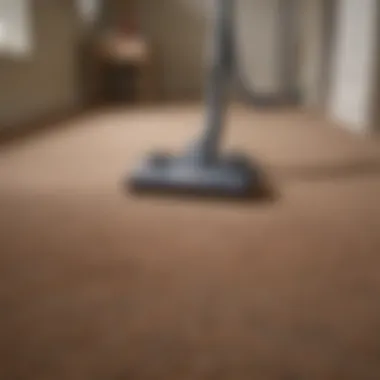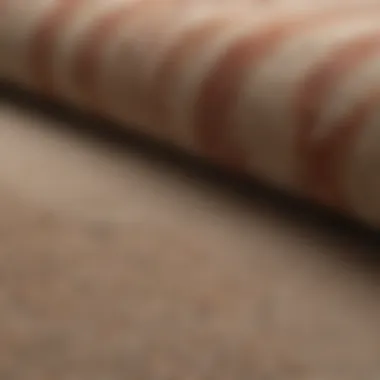Deep Cleaning Carpets: Techniques and Benefits


Intro
Deep cleaning carpets is an essential task for maintaining the aesthetics and hygiene of living spaces. Carpets accumulate dust, allergens, and stains over time, affecting not only their appearance but also the indoor air quality. Understanding the various techniques and methods available allows home enthusiasts to choose the most suitable approach for their needs. Moreover, with the right knowledge, individuals can enhance the durability and beauty of their carpets while minimizing unnecessary costs on professional cleaning services.
This article provides a thorough exploration of effective carpet cleaning practices, including the benefits associated with them and key considerations to keep in mind before starting the cleaning process. Readers will gain insightful knowledge to facilitate informed decisions regarding their carpet maintenance routines.
Featured Homes
Carpets play an integral role in the design and comfort of homes. They enhance the warmth and inviting nature of spaces. Understanding the architectural styles that often feature carpets, as well as unique design elements that complement them, is crucial for real estate enthusiasts.
Architectural Styles
- Traditional: Often features plush carpets that enhance warmth and coziness.
- Modern: Typically showcases low-pile carpets or even area rugs to maintain a clean, minimalist look.
- Industrial: May blend harder surfaces with carpets to provide comfort while maintaining a rugged aesthetic.
Each architectural style may necessitate different deep cleaning approaches based on the carpet type and material used.
Unique Design Elements
The choice of carpets can significantly impact a home's design. Factors such as color, texture, and pattern should harmonize with the overall decor. High-quality carpets may require specialized cleaning techniques to preserve their integrity and appearance.
Considering the specific elements of a home can guide readers in selecting the right carpets that suit their design preferences while also determining the most effective cleaning methods.
Techniques for Deep Cleaning Carpets
Deep cleaning carpets involves various methods that cater to different carpet types and levels of soiling. Here’s a breakdown of some popular techniques:
- Steam Cleaning: Uses hot water to clean carpets deeply, effectively removing dirt and stains. Ideal for high-traffic areas.
- Dry Cleaning: Involves applying a special cleaning powder that absorbs soiling and can be easily vacuumed up. This method dries faster than steam cleaning.
- Shampooing: Uses a foamy cleaning agent, suitable for heavily soiled carpets, though it requires thorough rinsing.
- Bonnet Cleaning: Best for surface cleaning, using a rotary machine with absorbent pads to lift stains.
Adopting the right technique based on the carpet’s material and condition can profoundly influence the cleaning results.
Benefits of Deep Cleaning Carpets
Deep cleaning carpets offers numerous benefits that extend beyond aesthetics. Key advantages include:
- Improved Air Quality: Reduces allergens and pollutants trapped in the carpet fibers.
- Enhanced Longevity: Regular deep cleaning helps extend the lifespan of carpets.
- Stain Removal: Effectively eliminates stubborn stains, maintaining the carpet’s appearance.
- Odor Elimination: Removes odors by targeting embedded particles and residues.
Considerations Prior to Cleaning
Before commencing the deep cleaning process, it's essential to assess various factors:
- Carpet Type: Determine whether the carpet is synthetic or natural; different materials require varying approaches.
- Stains: Identify types of stains, as specific stains might need special treatments.
- Environment: Consider the indoor environment and time needed for the carpet to dry post-cleaning.
By being mindful of these considerations, homeowners can ensure a thorough and effective cleaning process.
"Regular maintenance and cleaning not only enhances the appearance of carpets but also contributes to a healthier living environment."
Culmination
Deep cleaning carpets is a vital aspect of home care that offers both aesthetic and health benefits. By understanding various cleaning techniques, their respective advantages, and necessary considerations, homeowners can make informed choices for carpet maintenance. This knowledge not only enhances the beauty of carpets but also supports a cleaner, healthier indoor atmosphere.
Understanding Carpet Materials
Understanding carpet materials is crucial when contemplating deep cleaning techniques. Different carpets require different approaches due to the nature of their fibers. If the homeowner recognizes the fiber type, they can choose a cleaning method that best caters to its unique characteristics. This knowledge not only aids in effective cleaning but also in maintaining the appearance and longevity of the carpet.
Common Types of Carpet Fibers
Carpets can be classified into several types based on the fibers used in their construction. Each has its own set of properties and maintenance requirements. The most common carpet fibers include:
- Nylon: Renowned for its durability and resilience, nylon is often chosen for high-traffic areas. It holds dye well and resists fading, making it a popular choice in various households.
- Polyester: This fiber is appreciated for its softness and vibrant colors. While it is less durable than nylon, it offers good stain resistance and is often considered more affordable.
- Wool: A natural fiber, wool is prized for its elegance and comfort. It has the ability to absorb moisture, making it lesser prone to static. However, it requires careful cleaning to prevent shrinkage and damage.
- Olefin (Polypropylene): Known for its stain resistance and fade resistance, olefin is often used in outdoor carpets, as well. It is moisture resistant but tends to mat down over time if not cared for properly.
- Triexta: A newer fiber, triexta combines the durability of nylon with the softness of polyester. It is also known for its stain and soil resistance, making it a growing choice in modern homes.
Choosing the right carpet fiber affects not only how it looks but also how it responds to cleaning methods. It is essential for individuals to know what they are dealing with to make informed decisions.
Characteristics of Synthetic vs. Natural Fibers
The classification of carpet fibers often falls into two main categories: synthetic and natural fibers. Each type offers distinct characteristics that can influence cleaning techniques and overall carpet maintenance.
- Synthetic Fibers: These fibers, like nylon or polyester, tend to be more stain resistant and easier to clean due to their durable nature. They often combine performance with affordability, which makes them ideal for homes with children or pets.
- Natural Fibers: Carpets made from natural materials, like wool, usually have a luxurious feel and aesthetic appeal. However, they can be more vulnerable to stains and may require specific cleaning agents to avoid damage. Natural fibers often need gentler cleaning methods which may take longer but keep the material in good shape.
With this knowledge in hand, homeowners can select carpets that not only align with their design preferences but also with their capacity for care and maintenance.
Importance of Deep Cleaning Carpets


Deep cleaning carpets is crucial for maintaining a healthy and inviting indoor environment. Often overlooked, this task carries significant importance in a home or office setting. Clean carpets contribute to better air quality, enhance the aesthetic appeal, and prolong the life of the carpets. These aspects are not just beneficial; they are essential for any space with heavy foot traffic.
Health Benefits of Clean Carpets
One substantial benefit of deep cleaning carpets is the improvement in indoor air quality. Carpets can trap allergens, dust, pet dander, and other pollutants. Over time, these particles accumulate, potentially causing allergic reactions or respiratory issues. Regular deep cleaning helps remove these contaminants substantially. Health organizations emphasize the need for clean carpets, especially in homes with children or pets. A study suggests that clean carpets reduce allergy symptoms by up to 61%. In addition, removing bacteria and germs contributes to a healthier living environment, ensuring you can breathe easy.
Aesthetic Advantages
Aesthetically, clean carpets create a welcoming and pleasant atmosphere. They can define the overall look and feel of a room. When carpets are maintained correctly, colors appear vibrant, patterns stand out, and the texture feels fresh. Stains and dirt diminish the appeal of any space. Regular deep cleaning keeps carpets looking new and enhances the interior décor. A well-maintained carpet can elevate the overall design and charm of a home, making it more appealing to guests and even potential buyers.
Extending Carpet Lifespan
Investing time in deep cleaning also extends the lifespan of carpets, a financial consideration for any homeowner. Carpets can be expensive, and replacing them often requires significant investment. Dirt and debris act like abrasives, damaging the fibers over time. By removing this debris through deep cleaning, the durability of the carpets improves. It is often recommended to deep clean carpets every 6 to 12 months, depending on usage. This practice will maintain their appearance and feel, thus enhancing their longevity.
In summary, understanding the importance of deep cleaning carpets is vital for readers looking to maintain a pleasant home environment. The health benefits, aesthetic advantages, and potential cost savings from extending the lifespan of carpets underscore the necessity of this task.
Methods of Deep Cleaning Carpets
Deep cleaning carpets is not just a matter of aesthetics; it plays a crucial role in maintaining a healthy living environment. The right methods of deep cleaning can improve air quality by reducing allergens, deliver longer-lasting results, and enhance the overall lifespan of the carpet. Each cleaning method has its unique advantages and considerations that cater to different types of stains and fabrics. Therefore, understanding these methods is essential for effective carpet maintenance and care.
Hot Water Extraction (Steam Cleaning)
Hot water extraction, commonly known as steam cleaning, is one of the most popular methods for deep cleaning carpets. This method involves injecting hot water mixed with cleaning solution into the carpet fibers under high pressure. The water loosens dirt, allergens, and grime embedded deep in the fibers. It is then extracted along with the impurities using a powerful vacuum.
This technique not only cleans effectively but also sanitizes the carpet due to the high temperature of the water used. As a result, it is particularly beneficial for households with allergies. However, one must be cautious as excessive moisture can lead to mold growth if carpets are not dried properly.
Dry Foam Cleaning
Dry foam cleaning is another effective method for deep carpet cleaning. This cleaning process utilizes special foam technology, where a cleaning solution is whipped into a foam that is spread over the carpet. The foam encapsulates dirt and stains without soaking the material. After the foam dries, it is simply vacuumed away, removing the encapsulated dirt.
This technique is advantageous because it requires less drying time compared to other methods. Additionally, it is suitable for delicate carpets that cannot tolerate excessive moisture. However, the effectiveness may vary, and it might not be the best choice for heavily soiled carpets.
Dry Cleaning Method
The dry cleaning method is often considered a low-moisture option and is ideal for carpets that require quick cleaning. A dry cleaning compound is spread across the carpet, and then a machine with rotating brushes works through the fibers to agitate the compound and lift dirt. After allowing it to sit for a while, the remaining compound is vacuumed away.
This method is appreciated for its fast turnaround time and minimal water usage. It is particularly useful for commercial settings or homes where immediate use of a carpet is required. Nevertheless, it may not eliminate all stains and deep-seated dirt as effectively as other methods.
Bonnet Cleaning
Bonnet cleaning is frequently used for routine maintenance of commercial carpets. This method employs a rotary machine with a cleaning pad soaked in a professional-grade cleaning solution. The machine spins, agitating the carpet surface while lifting soil into the bonnet.
While bonnet cleaning is efficient for surface dirt and offers quick drying times, it does not penetrate deeply, making it less effective for heavy-duty cleaning. It is ideal for maintaining cleanliness between more thorough deep-cleaning sessions, especially in high-traffic areas.
Encapsulation Cleaning
Encapsulation cleaning is a modern technique that uses synthetic detergents which crystallize into powder when they dry. This powder encapsulates dirt particles, which can be easily vacuumed away after the carpet has dried. This method is effective for light to moderate soil levels and is very quick, allowing for immediate use of the carpet after cleaning.
Its benefit lies in the reduced moisture content, which lowers drying times significantly. However, it may not be suitable for deeply soiled carpets or those with extensive stains, as it’s geared more toward routine maintenance.
In summary, choosing the right method for deep cleaning carpets depends on several factors, including the type of carpet, the level of soiling, and personal preference. Understanding the strengths and limitations of various methods allows for more informed decisions in carpet care.
Essential Equipment for Deep Cleaning
Deep cleaning carpets requires the right equipment to achieve effective results. Choosing the correct tools is essential to not only remove dirt and stains but also to maintain the longevity of carpets. This section discusses the key equipment needed for deep cleaning, focusing on carpet cleaning machines, cleaning solutions, and the necessary accessories.
Carpet Cleaning Machines
Carpet cleaning machines play a crucial role in the deep cleaning process. These machines come in various types including rental units, home use machines, and commercial-grade equipment. The complexity of the carpet, its materials, and the level of dirtiness will significantly influence the choice of machine.
- Hot Water Extractors: This type uses heated water along with cleaning solutions to extract dirt and stains. The high temperature helps to break down the grime effectively.
- Steam Cleaners: Similar to hot water extractors, steam cleaners offer a deeper clean by using steam. This method can sanitize carpets, making it suitable for households with pets or allergies.
- Rotary Brush Cleaners: These machines scrub the carpet fiber using rotating brushes. This method is beneficial for carpets that need agitation to remove embedded soil.
Using appropriate machines enhances not just cleaning effectiveness but also reduces time and effort. Evaluating the features of these machines, such as suction power and capacity, can lead to better cleaning outcomes.
Types of Cleaning Solutions
The choice of cleaning solution also greatly impacts the effectiveness of deep cleaning carpets. Various formulations exist depending on the type of stain and carpet material.
- Enzymatic Cleaners: These solutions contain enzymes that break down organic stains, such as those from pets. They are effective for removing odors and tough stains without damaging the carpet.
- Foam Cleaners: These are easier to apply and can be rinsed off easily. They work well for spot cleaning and light stains.
- pH-Balanced Solutions: Ideal for delicate carpets, these solutions help maintain the carpet's structure while providing a thorough clean.
Always read the labels and ensure that a cleaner is suitable for the carpet type to avoid any damage. Following directions on dilution and application is essential for achieving optimal results.


Accessories and Tools
In addition to machines and solutions, certain accessories and tools are vital for a thorough deep cleaning process.
- Brushes: Stiff-bristle brushes can help agitate the carpet fibers, loosening dirt before extraction. They are particularly useful for high-traffic areas.
- Rakes: A carpet rake can lift up matted fibers and help distribute carpet cleaning solutions evenly across the surface.
- Spot Cleaners: For immediate and small stains, having a portable spot cleaner is beneficial. These machines are easy to use and target difficult areas without the need for full machine setups.
Having the right accessories at hand ensures a deeper clean. They also assist in maintaining the carpet’s appearance between deep cleaning sessions.
Consistent use of good quality equipment along with suitable methods can dramatically improve the cleanliness and longevity of carpets.
Common Carpet Stains and Their Solutions
Cleaning carpets is vital not only for maintaining aesthetics but also for promoting hygiene in the home. Stains are an inevitable part of carpet life. They occur due to spills, pet activity, or even outdoor tracking. Understanding common stains and their respective solutions can significantly enhance the effectiveness of your cleaning efforts. This section covers specific types of stains, offering methods for their removal and prevention.
Food and Drink Stains
Food and drink stains can vary from benign spills to troublesome spots. Items like red wine, coffee, or sauces often penetrate deep into carpet fibers, causing discoloration. Quick action is crucial. Start by blotting the area with a cloth to absorb excess liquid. Avoid rubbing, as it can spread the stain. For red wine stains, mixing one part water with one part white vinegar can help lift the stain. It is also essential to follow-up with cold water to rinse the area. Using absorbent cloths is key here. Another focal point is the regular application of protective solutions, which can assist in preventing tougher stains from taking hold.
Pet-related Stains
Pet stains pose a unique challenge. Urine can leave behind unpleasant odors if not treated promptly. Begin with blotting up as much as possible. Then, a mixture of white vinegar and water can neutralize odors while breaking down the stain. Always ensure the area is well-rinsed after treatment. Consider enzymatic cleaners, as they work specifically on organic material like pet waste. Furthermore, deploying preventative measures, like placing pet mats or training pets, can significantly reduce future incidents.
Mud and Soil Stains
Mud and soil stains are often tracked in from outside environments. Similar to other stains, timing is crucial. Allow the mud to dry first, which makes it easier to flake off. Once dried, using a vacuum can remove most of the debris. For remaining marks, a mixture of warm water and a few drops of dish soap can aid in cleaning. Be sure to rinse well after contacting the area with this solution. Just as with previous types of stains, regular maintenance can prevent mud from embedding further into the fibers.
Grease and Oil Stains
Grease and oil stains can be challenging due to their slippery nature. Blotting is key again; absorbent cloths will be beneficial. A product like cornstarch or baking soda can help absorb excess grease before applying a cleaning solution. For manual intervention, a solution of dish soap and warm water may help lift the stain. Similar to handling other types of stains, rinse thoroughly, as residues can attract dirt over time. Be aware that regular carpet cleaning and maintenance can serve as barriers against the absorption of such tricky stains.
Preventive Measures for Carpet Care
Preventive measures for carpet care play a critical role in maintaining the appearance and extending the lifespan of carpets. Taking proactive steps is essential not only for aesthetic reasons but also for the overall hygiene of indoor environments. Addressing potential issues before they arise reduces the need for extensive deep cleaning and can significantly lower long-term maintenance costs.
Regular Vacuuming
Regular vacuuming is arguably the most fundamental aspect of carpet care. It prevents dirt and dust from settling deep within the fibers, which can lead to dullness and wear over time. According to carpet cleaning experts, it is recommended to vacuum at least once a week in low-traffic areas and daily in high-traffic zones. Depending on the type of carpet, using the appropriate vacuum cleaner is vital.
- Use a vacuum with strong suction to lift dirt effectively.
- Consider a vacuum with a HEPA filter to trap allergens and improve air quality.
By following these practices, the maintenance of carpets becomes much easier and less frequent deep cleaning is required.
Use of Carpet Protectors
Using carpet protectors is an effective strategy to shield carpets from stains and damage. These products create a protective barrier on the carpet fibers, making it difficult for spills and dirt to penetrate. Applying a carpet protector can make a noticeable difference in the long-run health and appearance of carpets.
- Stain-resistant solutions can minimize the impact of everyday spills.
- UV protectors help prevent fading from sunlight exposure.
Investing in good quality carpet protectors, such as those from brands like 3M or Scotchgard, can yield significant benefits if you want your flooring to maintain its fresh appeal over time.
Setting Up Cleaning Schedules
Establishing a systematic cleaning schedule is crucial in retaining the look and quality of carpets. Planning routine maintenance activities ensures that your carpets remain spotless and free of allergens and odors. A good cleaning schedule generally consists of:
- Weekly vacuuming for maintenance.
- Monthly spot cleaning for stains and spills.
- Seasonal deep cleaning to remove built-up dirt and refresh the fibers.
By compartmentalizing the tasks into a regular routine, the burden of unexpected cleaning can be avoided. Such an approach not only ensures cleanliness but also preserves the value of the investment in your carpets.
"Consistent and mindful carpet care can lead to a healthier home and a more beautiful environment."
By employing preventive measures like regular vacuuming, using carpet protectors, and setting up cleaning schedules, homeowners can ensure their carpets will stand the test of time, making the space more inviting and reducing the need for drastic cleaning interventions.
When to Seek Professional Help
Determining when to seek professional help in carpet cleaning can often be a crucial decision. It involves assessing the degree of dirtiness, types of stains, and overall condition of the carpet. Professional cleaning services can provide a level of expertise and access to advanced equipment that ordinary consumers may not possess. This is particularly relevant for large, stubborn, or intricate cleaning challenges.
Signs That Indicate Professional Cleaning is Needed
Recognizing the signs that your carpet requires professional services is an essential skill for any homeowner. Here are some concrete indicators:
- Persistent Odors: If you notice lingering smells even after vacuuming and spot cleaning, it can be a sign that deep-seated dirt or mold is present.
- Visible Stains: If stains do not respond to your usual cleaning methods, they may require specialized treatment.
- Allergies or Respiratory Issues: A dirty carpet can exacerbate allergies. If family members exhibit allergy-like symptoms, a professional cleaning may provide relief.
- Carpet Color Deterioration: When you observe a noticeable change in the carpet color, especially from areas that receive more foot traffic, it indicates that cleaning is overdue.
- Regular Maintenance: Even if your carpet appears to be in good condition, it's beneficial to seek professional cleaning after a certain period to prolong its lifespan and maintain its appearance.


Always remember that taking proactive steps can save you costs in terms of both cleaning and possible carpet replacement down the line.
Choosing a Reliable Carpet Cleaning Service
Selecting an appropriate carpet cleaning service is equally as important as recognizing the need for one. The following tips can guide you in making an informed choice:
- Research and Reviews: Look for services with positive online reviews. Websites like Reddit and Facebook often provide user experiences that can be insightful.
- Service Variety: Ensure the company offers various cleaning methods tailored to different carpet types. This shows versatility and a deeper understanding of carpet care.
- Certifications and Expertise: Check if the service has necessary certifications. Proper training indicates a commitment to quality and safety standards.
- Insurance and Guarantees: A reputable cleaning service should be insured. Guarantees for satisfaction ensure you can hold them accountable for their performance.
When engaging a service, maintain clear communication regarding your carpet's specific needs and any particular stains or areas requiring special attention. By taking these steps, you invest in your home's appeal and hygiene.
Safety Considerations During Carpet Cleaning
When engaging in carpet cleaning, safety ought to be a primary concern. Improper practices or negligence can lead to both physical harm and damage to property. Awareness of safety elements is thus vital for ensuring not only effective cleaning but also the minimal risk of injury or damage. This section outlines essential precautions and considerations that contribute to a safer cleaning process.
Chemical Safety Precautions
One major aspect of carpet cleaning is the use of various cleaning solutions. These may contain chemicals that can pose a risk to health if mishandled. It is important to follow the manufacturer’s instructions carefully when using these products.
- Always use personal protective equipment (PPE), such as gloves and goggles, to minimize skin and eye exposure.
- Ensure proper ventilation in the area to avoid inhaling hazardous fumes. Open windows or use fans to create airflow during and after the cleaning process.
- Store all cleaning products in a secure location, particularly away from children and pets. Accidental ingestion or contact with skin can cause serious complications.
- Test a small area of the carpet with the cleaning solution before applying it broadly. This will help identify any adverse reactions of the carpet to the chemical used.
By adopting these safety measures, one can mitigate the risks associated with chemical use during carpet cleaning.
Protecting Furniture and Belongings
Carpet cleaning can be a disruptive process, often involving movement and placement of furniture. Protecting your belongings is crucial to avoid unnecessary damage. Here are some steps to consider:
- Move furniture: Before starting the cleaning process, relocate all furniture away from the carpeted area. This not only facilitates cleaning but also prevents stains from cleaning solutions seeping onto furniture.
- Use protective covers: If moving large items is not feasible, cover them with plastic sheets or old towels to avoid moisture or staining from cleaning products.
- Secure small items: Small decorative objects, electronic devices, or personal belongings should be stored safely away. This ensures they do not get lost or broken during the cleaning process.
- Be cautious with heavy items: Avoid dragging heavy furniture across carpets, as this can not only damage the carpet fibers but also result in personal injury through strain or confusion of movement.
Taking these protective measures can save you time and money in repairs while facilitating a smoother cleaning experience.
Remember, safety in carpet cleaning is not just about the cleaning methods but also about preparation and awareness of your surroundings.
Evaluating the Effectiveness of Carpet Cleaning
Evaluating the effectiveness of carpet cleaning is an essential aspect of maintaining carpets. Effective cleaning goes beyond just surface appearance; it involves ensuring that carpets are free from dirt, allergens, and odors. Understanding how to assess the results of carpet cleaning can help homeowners and professionals determine the need for additional cleaning or specific treatment methods.
In this section, key elements of effectiveness evaluation include assessing residual odors and inspecting for stain removal. Addressing these points provides insight into whether the cleaning methods used have achieved their intended purpose, ultimately enhancing the longevity and aesthetics of carpets.
Assessing Residual Odors
Residual odors often indicate that cleaning has not been fully effective. After a carpet cleaning process, any lingering smells can detract from a room's comfort and appeal. To assess residual odors:
- Wait for Carpet to Dry: Freshly cleaned carpets can have moisture that contributes to temporary odors. Allowing the carpet to dry fully is crucial for accurate assessment.
- Sniff Test: Once dry, perform a simple sniff test. Move around the room and evaluate areas where the odor was strongest. A clean carpet should have a neutral smell without any unpleasant scents.
- Check for Visual Indicators: Sometimes, odors can be tied to visible stains or soiling. Even if the carpet looks clean, hidden residues might be causing smells.
- Identify Possible Causes: If odors remain, consider if they stem from underlying issues. These might include mold, mildew, or residual cleaning chemicals that require further action or different cleaning methods.
By using these techniques, users can evaluate the freshness of their carpets and determine whether further cleaning is necessary.
Inspecting for Stain Removal
Stains are a common concern for carpet owners. Evaluating the effectiveness of carpet cleaning includes a thorough inspection for any remaining stains. This aspect assesses whether cleaning methods are adequate or if alternate approaches are required. Here’s how to inspect properly:
- Visual Inspection: Get down to the level of the carpet and closely examine stained areas from multiple angles. Often, lighting can reveal stains that are not immediately apparent; pay attention especially to high-traffic areas.
- Texture Feel: Run your fingers over the carpet fibers where stains were present. If they feel sticky or grimy, it is a sign that the cleaning was ineffective. A clean fiber should feel smooth and fresh.
- Use a Wet Cloth Test: For stubborn stains, lightly dampen a white cloth and blot the area. If color transfers to the cloth, it suggests residual dirt or cleaning solution is still present.
- Consider Stain Type: Some stains require specialized treatments. If certain stains are not completely removed, it might be necessary to apply specific cleaning solutions tailored for those particular stains, such as pet stains or ink.
Overall, evaluating stain removal not only affects visual appeal but also prevents long-term damage to carpet fibers.
"Regular assessment of both odors and stains ensures that carpets remain in optimal condition, ultimately preserving their value and enhancing home aesthetics."
Cost Considerations for Deep Cleaning
Understanding the financial implications of deep cleaning carpets is crucial for homeowners and renters alike. These costs can vary significantly based on methods chosen, size of the area to be cleaned, and condition of the carpets. Knowing how to budget effectively ensures that you can maintain the cleanliness and appearance of your carpets without straining your finances. The goal here is to examine the elements that influence costs, as well as provide a cost comparison between DIY and professional cleaning options that could save money in the long run.
Factors Influencing Cost
Several factors come into play when determining the cost of deep cleaning carpets. Breaking these down can help you grasp what contributes to overall expenses:
- Size of Carpet Area: Larger carpeted areas will inevitably cost more to clean, whether through professional services or DIY methods.
- Type of Cleaning Method: Techniques like hot water extraction typically incur different costs compared to dry cleaning or encapsulation methods. Each method has its own pricing structure based on equipment and time needed.
- Stain Removal Needs: Heavily stained or heavily soiled carpets will require more effort and possibly more specialized products, leading to increased labor and material costs.
- Accessibility: The layout of the space can affect pricing. Difficult-to-reach areas may take longer to clean, adding to the overall bill.
- Condition of Carpets: Older or more worn carpets often need extra care. If repairs are needed, costs can go up significantly.
Cost Comparison of DIY vs. Professional Cleaning
When deciding between DIY cleaning and hiring professionals, cost is often a key consideration. Each approach has its advantages and downsides:
- DIY Cleaning Costs:
- Professional Cleaning Costs:
- Cost of rental equipment can range from $30 to $60 per day, plus the price of cleaning products.
- You may save money if you already have suitable tools at home.
- It requires your time and effort, which is often underestimated.
- Average costs for professional deep cleaning can vary from $100 to $300 for typical rooms depending on additional services required.
- Always includes trained staff who can effectively handle stains or problematic carpet types.
- Time-efficient as professionals can complete the job faster than most DIY approaches.
"Choosing between DIY and professional cleaning often hinges on a careful analysis of both time and money, together with the specific conditions of your carpet."















